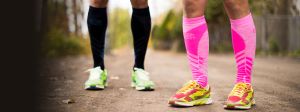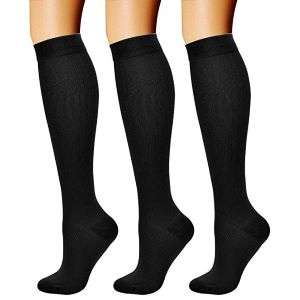
What are Compression Socks?
Compression socks are specially designed socks that feature compression therapy, which is where light pressure is applied to the legs, ankles, and feet to improve blood circulation.
This aims to prevent and/or treat various circulatory issues, ranging from mild aches to varicose veins. They can be worn in any weather, thanks to their breathable material, so you won’t overheat during summer!
Benefits of Compression Socks
There are various benefits from wearing compression socks, such as the following:
- Improving blood circulation in the legs, ankles, and feet,
- Providing support to the veins,
- Preventing and/or treating various circulatory issues, including:
– Edema
A medical term for swelling, which is when the blood vessels and capillaries allow too much water to build up within the tissues.
– Lymphedema
This occurs when a body part swells from too much lymph fluid, which happens when there is an issue with the regular drainage of lymph fluid into your blood.
– Chronic peripheral venous insufficiency
This is where the veins cannot effectively transport de-oxygenated blood back to the heart.
– Deep vein thrombosis
This occurs when blood flow decreases (especially in the lower extremities), causing blood to pool in the legs and leading to blood clot (thrombus) formation.
Who Can Wear Compression Socks
Almost anyone can wear compression socks. A couple examples are as follows:
1. Active Individuals

During exercise, the muscles endure a lot of strain. This can lead to aches during the recovery period.
Compression socks apply gentle pressure onto the muscles, minimizing the risk of damage and injury, as well as boosting blood circulation to help remove waste and lactic acid quicker, which helps reduce aches. These socks also tend to have a moisture-wicking feature, which allows you to also exercise in the heat without worrying about sweat buildup in the socks, allowing the feet to remain cool.
2. Nurses and Working Individuals

Standing or sitting for long hours can cause legs to ache and feet or ankles to swell. Wearing compression socks improve blood flow which would prevent blood from pooling in a certain part of the leg and fluid build-up.
Types of Compression Socks

1. Non-Medical Support Hosiery
- Frequently used to relieve tired legs.
- Has lesser compression than anti-embolism stockings and graduated compression stockings.
- Compression is uniform, not graduated.
- Can be purchased over-the-counter without a prescription.
2. Anti-Embolism Stockings
- Used to reduce the risk of deep vein thrombosis.
- Has graduated compression.
- Typically for individuals with restricted movement or have to bed-rest.
3. Graduated Compression Stockings
- Applies the highest degree of compression at the ankles then decreases upwards.
- Used to treat venous illness and edema.
- Typically for individuals without limited movement but require doctor’s supervision.
Popular Articles on ComproGear
Compression Sock Sizes How Do You Know What Size Compression Socks to Buy?
Compression Levels Available
As compression socks come in various compression levels as each is for a different need. The amount of pressure is measured in ‘millimeters of mercury (mmHg)’; the higher the level, the greater the pressure applied.
1. Mild Compression Level: 8-15 mmHg
This level is the lightest compression level and is great for providing relief to aching legs and minor swelling. This level is recommended for beginners.
2. Firm Compression Level: 15-20 mmHg
This compression level is slightly firmer and assists in preventing or treating minor swelling and pain. They are ideal for long-distance travel and when movement is limited.
3. Medical Grade I: 20-30 mmHg
This level is the first Medical Grade class and offers compression treat various kinds of conditions, such as varicose veins, edema, and deep vein thrombosis.
4. Medical Grade II: 30-40 mmHg
This second Medical Grade class of compression is used to treat serious edema, varicose veins, and deep vein thrombosis. This level of compression should only be worn under a doctor’s supervision.
5. Medical Grade III: 40-50 mmHg
This is the highest level of compression available and should only be worn under a doctor’s supervision. This level is used for treating venous issues and post-thrombotic disorder.
Side Effects from Wearing Compression Socks

- If compression socks are worn at a size too small, this could lead to restriction of blood flow and cause swelling or aches.
- If they are worn at a size too large, then this would not give effective results.
- Compression socks can have a mixed material composition; if you are allergic to a certain type of material, then your skin may become irritated or you may have an allergic reaction.
Tips for Wearing Compression Socks

- Make sure your skin is dry as damp skin makes it harder to put the socks on.
- Sit on a flat surface for steadiness while putting the socks on.
- Check for creases or folds; smooth them out.
- Replace them regularly, such as every six months or when they start to lose their elasticity.
- Do not wear them overnight.
Conclusion
Compression socks promote good blood circulation while also keeping you from overheating due to a moisture-wicking feature. They can be worn for exercise, work or just as daily wear. They are generally available in three types and have different compression levels to meet different needs. It is important to pick the right size and material for maximum benefit.
This page last updated December 15, 2022
